Land Vulnerability, Risk Zoning, and Ecological Protection in the Protection Forest of Pagaibamba (Peru)
Abstract
:1. Introduction
2. Materials and Methods
2.1. Site Description
2.2. Cartographic Materials
2.3. Remote Sensing Cartographic Materials
2.4. Design
2.5. Analysis
3. Results
3.1. Delimitation and Identification of Physiographic Units
3.2. Identification and Delimitation of the Soils Units
3.3. Identification and Delimitation of the Land Units
3.4. Risk Zoning Criteria and Ecological Protection
3.5. Determination of Risk Zones and Ecological Protection
4. Discussion
4.1. Main Risk Zones Identified and Categorized in Pagaibamba Protection Forest
4.2. Activities for the Conservation and Protection of PPF Buffer Zone
4.3. Why Is It Important to Maintain the Montane Forest Ecosystem in the PPF
4.4. Endemic Flora and Fauna Species That Protect the Montane Forests of the PPF
4.5. Changes in Land Use Natural and Man-Made Threat
5. Conclusions
Supplementary Materials
Author Contributions
Funding
Institutional Review Board Statement
Informed Consent Statement
Data Availability Statement
Acknowledgments
Conflicts of Interest
References
- Morgan, R.P.C. Soil Erosion and Conservation, 2nd ed.; Longman Group and J. Wiley & Sons: Essex, UK, 1997; p. 198. [Google Scholar]
- Oldeman, L.R. The Global Extent of Soil Degradation. In Soil Resilience and Sustainable Land Use; Greenland, D.J., Szabolcs, I., Eds.; CAB International: Wallingford, UK, 1994; pp. 99–118. [Google Scholar]
- FAO; ITPS. The Status of the World’s Soil Resources (Main Report); Food and Agriculture Organization of the United Nations: Rome, Italy, 2015; Available online: https://www.fao.org/3/i5199e/I5199E.pdf (accessed on 7 January 2022).
- Regoyos Sáinz, M. Metodología Para la Evaluación de la Erosión Hídrica Con Modelos Informáticos. Aplicación del Modelo Geowepp a dos Pequeñas Cuencas en Madrid. Ph.D. Thesis, Universidad Politécnica de Madrid, ETSIA, Madrid, Spain, 2003; p. 466. [Google Scholar]
- Bathurst, J.C.; Moretti, G.; El-Hames, A.; Beguería, S.; García-Ruiz, J.M. Modelling the impact of forest loss on shallow landslide sediment yield, Ijuez river catchment, Spanish Pyrenees. Hidrol. Earth Syst. Sci. 2007, 11, 569–583. [Google Scholar] [CrossRef]
- Valle, R.S. Las Áreas Naturales Protegidas en México. Un Ejemplo de Propuesta de Gestión de un Área Protegida y Plan de Manejo en “La Sierra de Monte Escobedo” (Zacatecas, México). Ph.D. Thesis, Universitat Autónoma de Barcelona, Barcelona, Spain, 2006. [Google Scholar]
- MINAM. Patrimonio Forestal a Nivel de Grandes Paisajes. Región Amazónica. Informe I. Ministerio del Ambiente. Vice-Ministerio de Desarrollo Estratégico de Recursos Naturales; Dirección General de Evaluación, Valoración y Financiamiento del Patrimonio Natural: Lima, Perú, 2009. [Google Scholar]
- DPOUT. Dirección Provincial de Ordenamiento Urbano y Territorial. Sistemas de Información Geográfica para el Ordenamiento Territorial. Subsecretario de Urbanismo y Vivienda; Ministerio de Infraestructura: Buenos Aires, Argentina, 2011; p. 94. [Google Scholar]
- Eastman, J. IDRISI Taiga Guide to GIS and Image Processing; Clark Labs, Clark University: Worcester, MA, USA, 2009. [Google Scholar]
- Valdez, M.E.; Mireles, P.; Orozco, M.E. Aplicación de los Sistemas de Información Geográfica para Ordenamientos Ecológicos en Áreas Naturales Protegidas. Rev. Geográfica América Cent. 2011, 2, 1–19. [Google Scholar]
- Ranjan, A.K.; Vallisree, S.; Singh, R.K. Role of Geographic Information System and Remote Sensing in Monitoring and Management of Urban and Watershed Environment: Overview. J. Remote Sens. GIS 2016, 7, 1–14. [Google Scholar]
- CONANP. 100 Años de Conservación en México. Áreas Naturales Protegidas 1917–2017. Comisión Nacional de Áreas Naturales (CONANP) Secretaría de Medio Ambiente y Recursos Naturales. Primera Edición. Ejército Nacional 223, Miguel Hidalgo, México. 2018. Available online: https://www.conanp.gob.mx/pdf/100AñosConservación.pdf (accessed on 8 January 2022).
- SERNANP. Análisis de la Vulnerabilidad de las Áreas Naturales Protegidas Frente al Cambio Climático al 2030, 2050 y 2080. Servicio Nacional de Áreas Naturales Protegidas por el Estado—SERNANP; World Wildlife Fund, WWF: Lima, Perú, 2015; p. 87. Available online: http://sis.sernanp.gob.pe/biblioteca/index.jsp?publicacion=595 (accessed on 7 January 2022).
- Sherbinn, A.; Freudenberger, M. Migration to protected areas and buffer zones: Can western the tide? PARKS 1998, 8, 38–53. [Google Scholar]
- Muñoz, F.; Navarro, R. El Empleo de Sensores Remotos Como Herramienta Para la Generación de Cartografía de Usos del Suelo en el Entorno de Áreas Naturales Protegidas: Aplicación al Bosque de Protección de Alto Mayo y su Zona de Amortiguamiento(Perú). In Las Zonas de Amortiguamiento: Un Instrumento Para el Manejo de la Biodiversidad. El Caso de Ecuador, Perú y Bolivia; Blanes, J., Navarro, R., Drehwald, U., Eds.; Comisión Europea: Bruselas, Bélgica, 2003; pp. 215–234. [Google Scholar]
- MINAG. Ley de Áreas Naturales Protegidas, Ley 26834; Congreso de la República del Perú: Lima, Peru, 1997. [Google Scholar]
- SERNANP. Plan Maestro del Bosque de Protección Pagaibamba 2017–2021; Servicio Nacional de Áreas Naturales Protegidas por el Estado (SERNANP): Cajamarca, Perú, 2017; p. 70. [Google Scholar]
- Díaz, R.; Miranda, J. Áreas Naturales Protegidas en el Perú: Efectos Sobre la Deforestación y su Relación con el Bienestar de la Población Amazónica; IEP, Instituto de Estudios Peruanos: Lima, Peru, 2012; p. 46. [Google Scholar]
- SERNAMP. Servicio Nacional de Áreas Naturales Protegidas por el Estado. 2013. Available online: https://www.sernanp.gob.pe (accessed on 6 June 2021).
- GEO-ANP. Información Geográfica de las Áreas Naturales Protegidas del Peru. 2021. Available online: https://www.gob.pe/8532geo-anp (accessed on 7 June 2021).
- Zonas Reservadas. 2020. Available online: https://www.sernanp.gob.pe/el-sinanpe (accessed on 24 December 2021).
- SERNANP. 2017. Available online: http://www.sernanp.gob.pe/de-pagaibamba (accessed on 19 April 2021).
- Hansen, A.J.; Piekielek, N.; Davis, C.; Haas, J.; Theobald, D.M.; Gross, J.E.; Monahan, W.B.; Olliff, T.; Running, S.W. Exposure of U. S. National Parks to land use and climate change 1900–2100. Ecol. Appl. 2014, 24, 484–502. [Google Scholar] [CrossRef] [PubMed]
- IIAP. Zonificación Ecológica Económica de la Cuenca del Río Aguaytía. Cap 5 Potencial y Limitaciomes del Territorio y de sus Recursos Naturales; Instituto de Investigación de la Amazonía Peruana: Iquitos, Peru, 2000. [Google Scholar]
- UNDRO. Preliminary Study on the Identification of Disaster-Prone Countries Based on Economic Impact; United Nations Disaster Relief Organisation: New York, NY, USA; Geneva, Switzerland, 1990. [Google Scholar]
- MINAM. Memoria Descriptiva del Mapa de Vulnerabilidad Física del Peru. Ministerio del Ambiente (MINAM). Viceministerio de Gestión Estratégica de Recursos Naturales. Dirección General de Ordenamiento Territorial; Equipo Técnico de Vulnerabilidad: Lima, Peru, 2011; Available online: https://repositoriodigital.minam.gob.pe/handle (accessed on 18 February 2021).
- Senamhi. Servicio Nacional de Meteorología e Hidrología del Peru. 2014. Available online: http://www.senamhi.gob.pe (accessed on 24 March 2021).
- Holdridge, L.R. Life Zone Ecology; Tropical Science Center: San José, Costa Rica, 1967; p. 210. [Google Scholar]
- Roncal, M.R. Bosque de Protección Pagaibamba. Estudio de línea Base. Línea Base de Flora y Fauna del Bosque de Protección Pagaibamba. Gobierno Regional de Cajamarca. Prov. Chota; Departamento de Cajamarca: Cajamarca, Peru, 2018; p. 224. Available online: https://siar.regioncajamarca.gob.pe/documentos/linea-base-flora-fauna-bosque-proteccion-pagaibamba-marco-proyecto (accessed on 3 June 2021).
- IGN. Instituto Geográfico Nacional. Gobierno del Peru. 2013. Available online: https://www.gob.pe/ign (accessed on 13 January 2021).
- INGEMMET. Instituto Geológico Minero y Metalúrgico del Peru. Available online: https://www.gob.pe/ingemmet (accessed on 23 December 2021).
- IDERC. Infraestructura de Datos Espaciales Regionales de Cajamarca; Gobierno Regional de Cajamarca: Cajamarca, Peru, 2016; Available online: https://www.geoidep.gob.pe/gobierno-regional-cajamarca (accessed on 23 December 2021).
- GORECajamarca. Gobierno Regional Cajamarca: Cajamarca, Peru, 2016. Available online: https://www.regioncajamarca.gob.pe (accessed on 24 December 2021).
- MINAGRI. Ministry of Agriculture and Irrigation at Present MIDAGRI, Ministry of Agrarian Development and Irrigation. 2014. Available online: https://www.limaeasy.com/peru-guide/business-guide-peru/peruvian-ministries/ministry-of-agrarian-development-and-irrigation-midagri (accessed on 28 May 2021).
- INRENA. Instituto Nacional de Recursos Naturales ahora Ministerio de Desarrollo Agrario y Riego. MIDAGRI. Available online: https://siea.midagri.gob.pe/portal/ (accessed on 30 November 2021).
- GeoIDEP. Información del IDEP. Infraestructura de Datos Espaciales del Peru (IDEP). 2014. Available online: https://www.geoidep.gob.pe/ign (accessed on 19 June 2021).
- WMS. Web Map Service. Servicios WMS para Visualizar Mapas. Visor de la IDEP. Gobierno del Peru. 2015. Available online: https://www.geoidep.gob.pe/servicios-idep/catalogo-nacional-de-servicios-web (accessed on 23 December 2021).
- Villota, H. El Sistema CIAF de Clasificación Fisiográfica del Terreno. Rev. CIAF 1992, 13, 55–70. [Google Scholar]
- Alcántara, G.H. Fisiografía del departamento de Cajamarca; Gobierno Regional de Cajamarca: Cajamarca, Peru, 2011; p. 28. [Google Scholar]
- United States Department of Agriculture. Natural Resources Conservation Service: Division of Soil Survey. Soil Survey Manual. In USDA Handbook 18; United States Department of Agriculture: Washington, DC, USA, 2017; p. 593. [Google Scholar]
- Soil Survey Staff. Keys to Soil Taxonomy, 12th ed.; USA Department of Agriculture Natural Resources Conservation Service: Washington, DC, USA, 2014; p. 340. [Google Scholar]
- MINAG. Reglamento de Clasificación de Tierras; D.S 017-2009-AG; Gobierno del Peru: Lima, Peru, 2009. [Google Scholar]
- Rodríguez, E.M. GIS Techniques Potential for Environmental Management: An Application to Erosion Assessment. Rev. Electrónica Medioambiente 2007, 5, S76. [Google Scholar]
- Nagata, S.M. Los Sistemas de Información Geográfica SIG. Una Herramienta en la Gestión del Espacio Propuesta un Mapa de Aptitud de Suelos en la Cuenca Hidrográfica del Colca. Arequipa, Peru. 1996. Available online: http://Dialnet-LosSistemasDeInformaciónGeográficaSIG-5339434%20 (accessed on 10 April 2021).
- Rigaux, P.; Scholl, M.; Voisard, A. Spatial Data Base with Applications to GIS; Morgan Kaufmann Publishers: Burlington, MA, USA, 2002; p. 440. [Google Scholar]
- MINAM. Guía de Evaluación del Estado de Ecosistemas de Bosque Seco: Bosque Estacionalmente Seco de Llanura y Bosque Estacionalmente Seco de Colina y Montaña. Ministerio del Ambiente (MINAM). Viceministerio de Desarrollo Estratégico de los Recursos Naturales; Dirección General de Ordenamiento Territorial Ambiental (DGOTA) Dirección de Monitoreo y Evaluación de los Recursos Naturales del Territorio: Lima, Peru, 2019; p. 60. Available online: https://sinia.minam.gob.pe/documentos/guia-evaluacion-estado-ecosistemas (accessed on 18 February 2021).
- López, M.J.; Bertoni, M.; Testa, J. Importance of natural protected areas in coastal tourism in Province of Buenos Aires. FACES 2012, 38–39, 173–189. [Google Scholar]
- Sánchez, I.; Sánchez, A. La Diversidad Biológica en Cajamarca, 1st ed.; Proyecto Determinación del Potencial de la Biodiversidad Regional de Cajamarca: Cajamarca, Peru, 2012; p. 208. [Google Scholar]
- Mararakanye, N.; Sumner, P.D. Gully erosion: A comparison of contributing factors in two catchments in South Africa. Geomorphology 2017, 288, 99–110. [Google Scholar] [CrossRef] [Green Version]
- Paino, M.; Rienzi, E.A. Erosión Hídrica y Selectividad en Cultivos en Contorno en un Suelo de Textura Franco-Limosa; Cátedra de manejo y Conservación de Suelos de la UBA: Buenos Aires, Argentina, 2008; p. 37. [Google Scholar]
- Liu, Y.F.; Liu, Y.; Shi, Z.H.; Lopez-Vicente, M.; Wu, G.L. Effectiveness of re-vegetated forest and grassland on soil erosion control in the semi-arid Loess Plateau. Catena 2020, 195, 104787. [Google Scholar] [CrossRef]
- Li, Q.; Liu, G.B.; Zhang, Z.; Tuo, D.F.; Bai, R.R.; Qiao, F.F. Relative contribution of root physical enlacing and biochemistrical exudates to soil erosion resistance in the Loess soil. Catena 2017, 153, 61–65. [Google Scholar] [CrossRef]
- Rodríguez, D.; D’Elía, G.; Ortega, H.; Aguilar, C. Taxonomic evaluation of the marsupial frog Gastrotheca peruana (Amphibia: Hemiphractidae) based on mitochondrial 16S rRNA gene. Rev. Peru. Biol. 2019, 26, 461–468. [Google Scholar] [CrossRef] [Green Version]
- FAO. Guía de Buenas Prácticas Para la Gestión y uso Sostenibles de los Suelos en Áreas Rurales. 2018. Available online: http://www.fao.org/3/i8864es/I8864ES.pdf (accessed on 18 April 2021).
- Escobedo Torres, R.; Rabanal Rosillo, H. Capacidad de uso Mayor de las Tierras. Diagnóstico y Plan de Ordenamiento Territorial en el Ámbito del Proyecto de Caficultura Sostenible de Alto Valor para Pequeños Agricultores; Dpto: San Martín, Peru, 2009; p. 66. [Google Scholar]
- FAO. El Estado de los Bosques del Mundo. Los Bosques y la Agricultura; Desafios y Oportunidades en Relación con el uso de la Tierra. 2016. Available online: http://www.fao.org/3/i5588s/i5588s.pdf (accessed on 19 April 2021).
- Servidoni, L.E.; Ayer, J.E.B.; Silva, M.L.N.; Spalevic, V.; Mincato, R.L. Land Use Capacity and Environment Services. Rev. Bras. Geogr. Física 2016, 9, 1712–1724. [Google Scholar] [CrossRef] [Green Version]
- FAO. Basic Principles of Conservation Agriculture. 2015. Available online: http://www.fao.org/3/i7480e/i7480e.pdf.FAO (accessed on 8 January 2021).
- Escobedo-Monge, M.A.; Aparicio, S.; Escobedo-Monge, M.F.; Marugán-Miguelsanz, J.M. Long-Term Effects of the Application of Urban Waste Compost and Other Organic Amendments on Solanum tuberosum L. Agronomy 2020, 10, 1575. [Google Scholar] [CrossRef]
- FAO. Las Amenazas a Nuestros Suelos. 2015. Available online: https://www.fao.org/3/mn997s/mn997s.pdf (accessed on 18 July 2021).
- MINAM. Estrategia Regional de Biodiversidad de Cajamarca al 2021. Ministerio del Ambiente (MINAM) Gerencia de Recursos Naturales y Gestión del Medio Ambiene del Gob; Regional de Cajamarca: Cajamarca, Peru, 2010; p. 153. [Google Scholar]
- Tejedor, N.; Garavito, E.; Álvarez, S.; Arango Caro, A.; Araujo Murakami, C.; Blundo, T.E.; Boza, T.E.; La Torre, M.A.; Gaviria, J.; Gutíerrez, N.; et al. Evaluación del Estado de Conservación de los Bosques Montanos en los Andes tropicales. Ecosistemas 2012, 21, 148–166. [Google Scholar]
- FAO. Carta Mundial de los Suelos; Organización de las Naciones Unidas para la Alimentación y la Agricultura: Roma, Italia, 2015. [Google Scholar]
- Bruijnzeel, L.A.; Kappelle, M.; Mulligan, M.; Scatena, F.N. Tropical Montane Cloud Forests: State of Knowledge and Sustainability Perspectives in a Changing World. In Tropical Montane Cloud Forests: Science for Conservation and Management; Bruijnzeel, L.A., Scatena, F.N., Hamilton, L.S., Eds.; Cambridge University Press: Cambridge, UK, 2010; pp. 691–700. [Google Scholar]
- Bruijnzeel, L.A.; Scatena, F.N.; Hamilton, L.S. Tropical Mountain Cloud Forests; Cambridge University Press: Cambridge, UK, 2011; Available online: https://www.cambridge.org/core/books/tropical-montane-cloud-forests (accessed on 18 May 2021).
- Jørgensen, P.M.; Ulloa, C.; León, B.; León-Yánez, S.; Beck, S.G.; Nee, M.; Zarucchi, J.L.; Celis, M.; Bernal, R.; Gradstein, R. Regional Patterns of Vascular Plant Diversity and Endemism. In Climate Change and Biodiversity in the Tropical Andes; Herzog, S.K., Martínez, R., Jørgensen, P.M., Tiess, H., Eds.; Inter-American Institute for Global Change Research (IAI) and Scientific Committee on Problems of the Environment (SCOPE): Singapore, 2011; pp. 92–203. [Google Scholar]
- De Rutte, J.; Reynel, C. Composición y Diversidad Arbórea en la Cumbre del Bosque Montano Nublado Puyu Sacha, Chanchamayo. Junín, Peru, 1st ed.; Centro de Estudios Dendrología-Fundación para el Desarrollo Agrario CED-FDA: Lima, Peru, 2016; p. 110. [Google Scholar]
- Anderson, E.P.; Marengo, J.; Villalba, R.; Halloy, S.; Young, B.; Cordero, D.; Gast, F.; Jaimes, E.; Ruiz, D. Consequences of Climate Change for Ecosystems and Ecosystem Services in the Tropical Andes. In Climate Change and Biodiversity in the Tropical Andes; Herzog, S.K., Martínez, R., Jørgensen, P.M., Tiessen, H., Eds.; Inter-American Institute for Global Change Research (IAI) and Scientific Committee on Problems of the Environment (SCOPE): Montevideo, Uruguay, 2011; pp. 1–18. Available online: http://www.iai.int/index.php?option=com_content&view=article&id=24&Itemid=73 (accessed on 9 January 2021).
- Helmer, E.H.; Gerson, E.A.; Scott Baggett, L.; Bird, B.J.; Ruzycki, S.; Vogesser, S.M. Neotropical cloud forests and p’aramo to contract and dry from declines in cloud immersion and frost. PLoS ONE 2019, e0213155. [Google Scholar] [CrossRef] [Green Version]
- Quenta-Herrera, E.; Crespo-Pérez, V.; Mark, B.; Gonzales, A.; Kulonen, A. Mountain freshwater ecosystems and protected areas in the tropical Andes: Insights and gaps for climate change adaptation. Environ. Conserv. 2022, 49, 17–26. [Google Scholar] [CrossRef]
- Bruijnzeel, L.A.; Scatena, F.N.; Hamilton, L.S. Tropical Montane Cloud Forests. In Science for Conservation and Management; Cambridge University Press: Cambridge, UK, 2010. [Google Scholar]
- Los, S.O.; Street-Perrott, F.A.; Loader, N.J.; Froyd, C.A. Detection of signals linked to climate change, land-cover change and climate oscillators in Tropical Montane Cloud Forests. Remote Sens. Environ. 2021, 260, 112431. [Google Scholar] [CrossRef]
- Los, S.O.; Street-Perrott, F.A.; Loader, N.J.; Froyd, C.A.; Cuní-Sanchez, A.; Marchant, R.A. Sensitivity of a tropical montane cloud forest to climate change, present, past and future: Mt. Marsabit, N. Kenya. Quat. Sci. Rev. 2019, 218, 34–48. [Google Scholar] [CrossRef]
- Bruijnzeel, L.A. Hydrological functions of tropical forests: Not seeing the soil for the trees? Agric. Ecosyst. Environ. 2004, 104, 185–228. [Google Scholar] [CrossRef]
- UICN. Unión Internacional para la Conservación de la Naturaleza. 2017. Available online: https://www.iucn.org/es (accessed on 24 April 2021).
- Decreto Supremo 004-2014-MINAGRI. Clasificación de Especies Amenazadas de Fauna Silvestre. 2014. Available online: http://extwprlegs1.fao.org/docs/pdf/per132692.pdf (accessed on 10 May 2021).
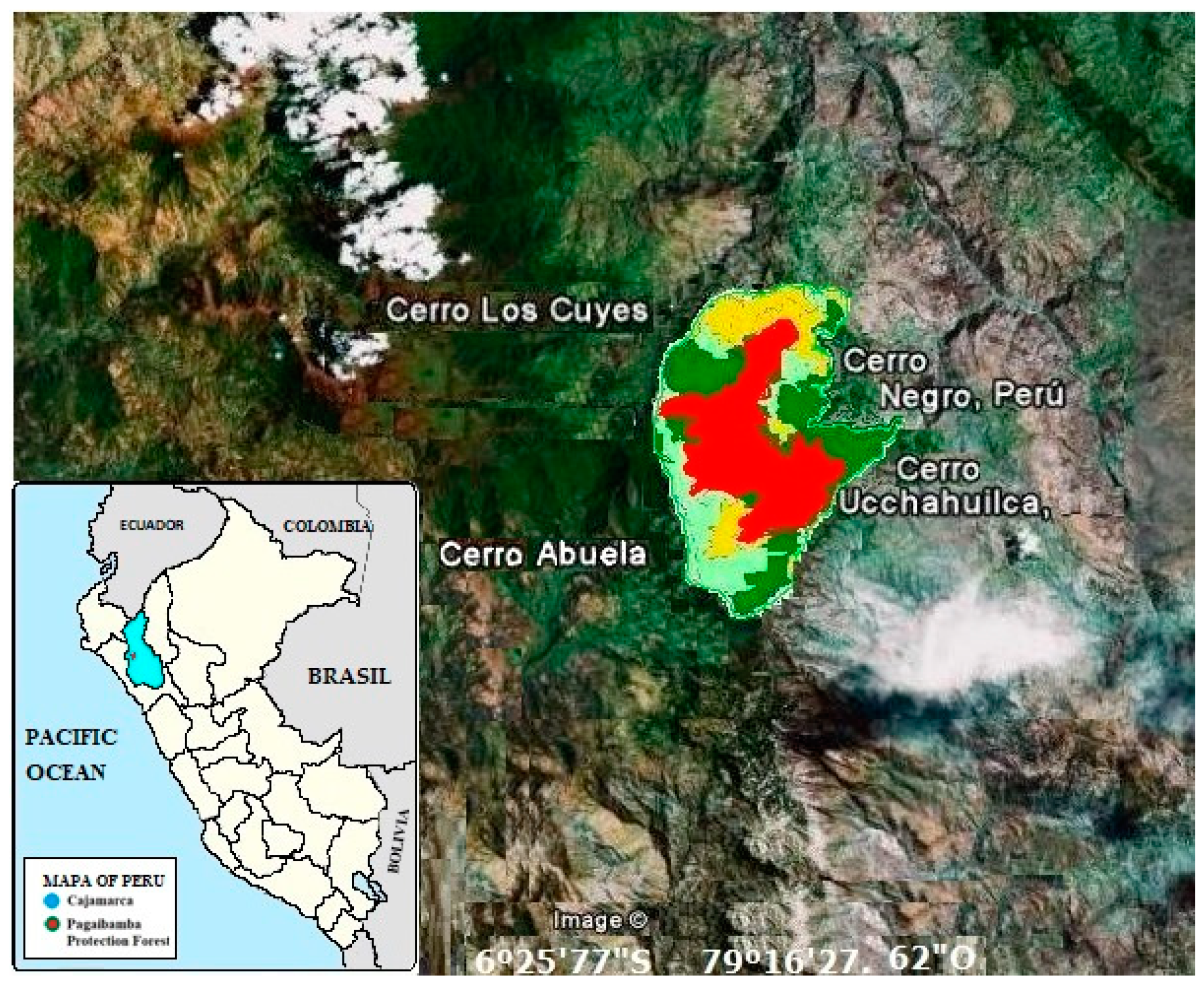

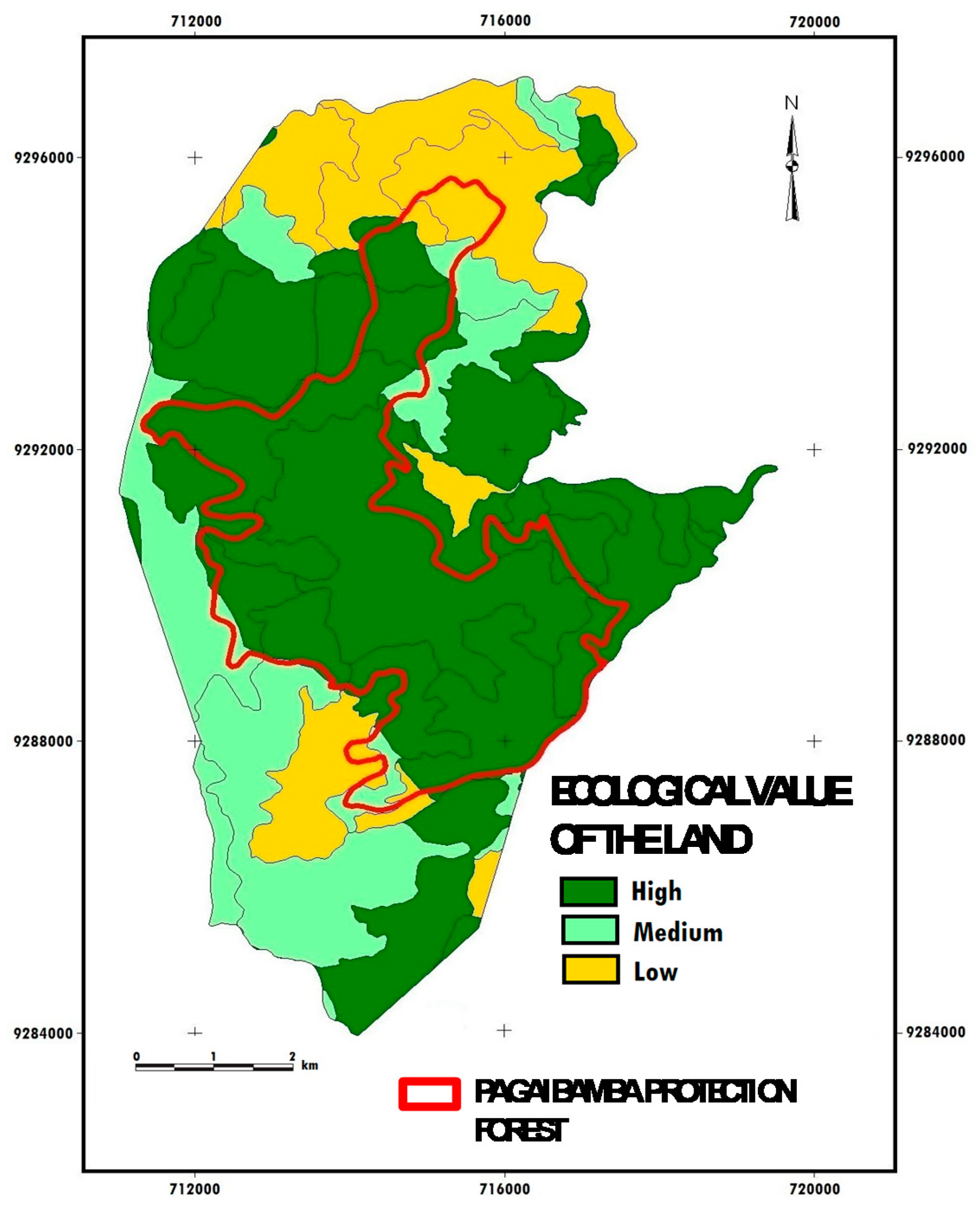
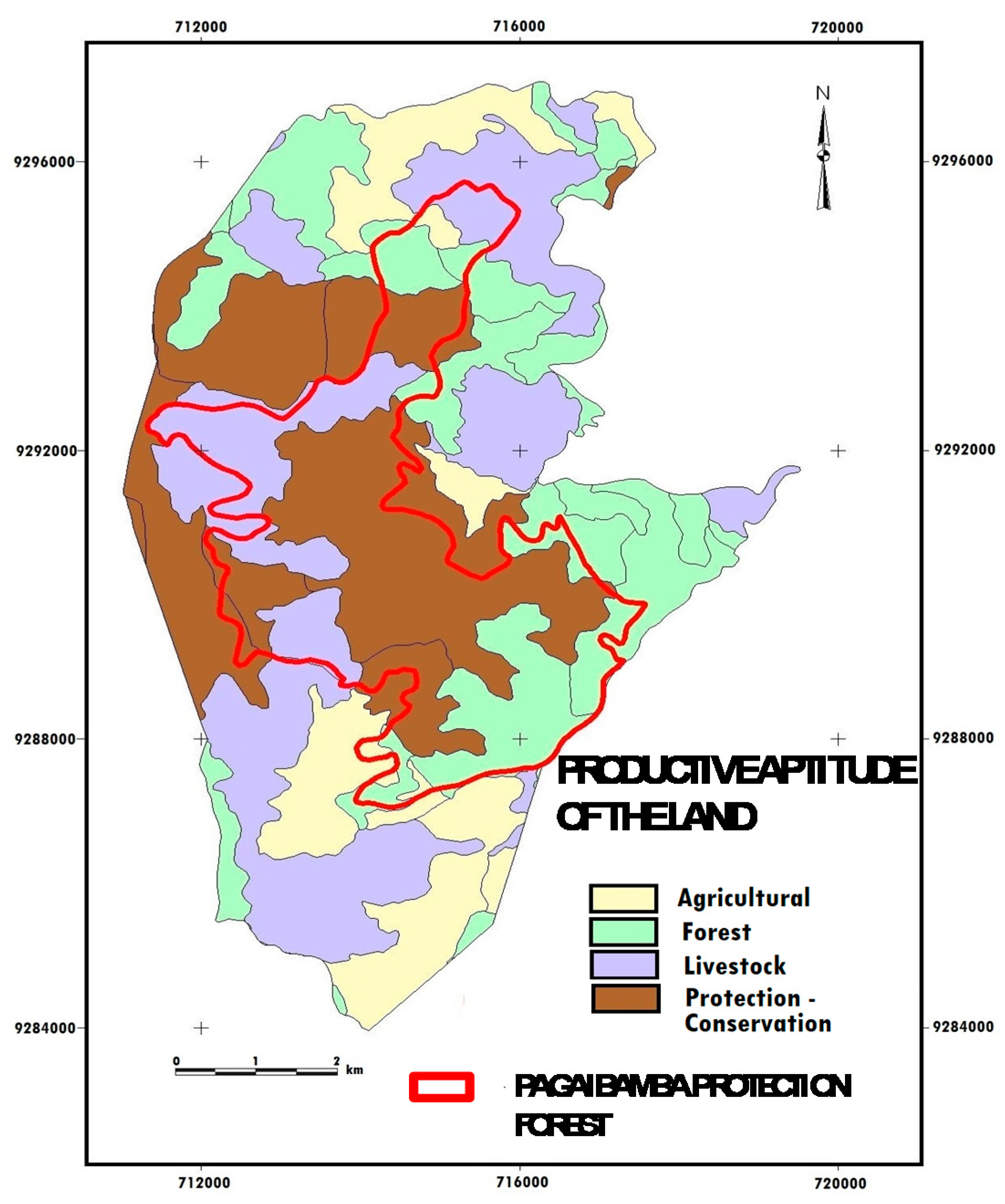
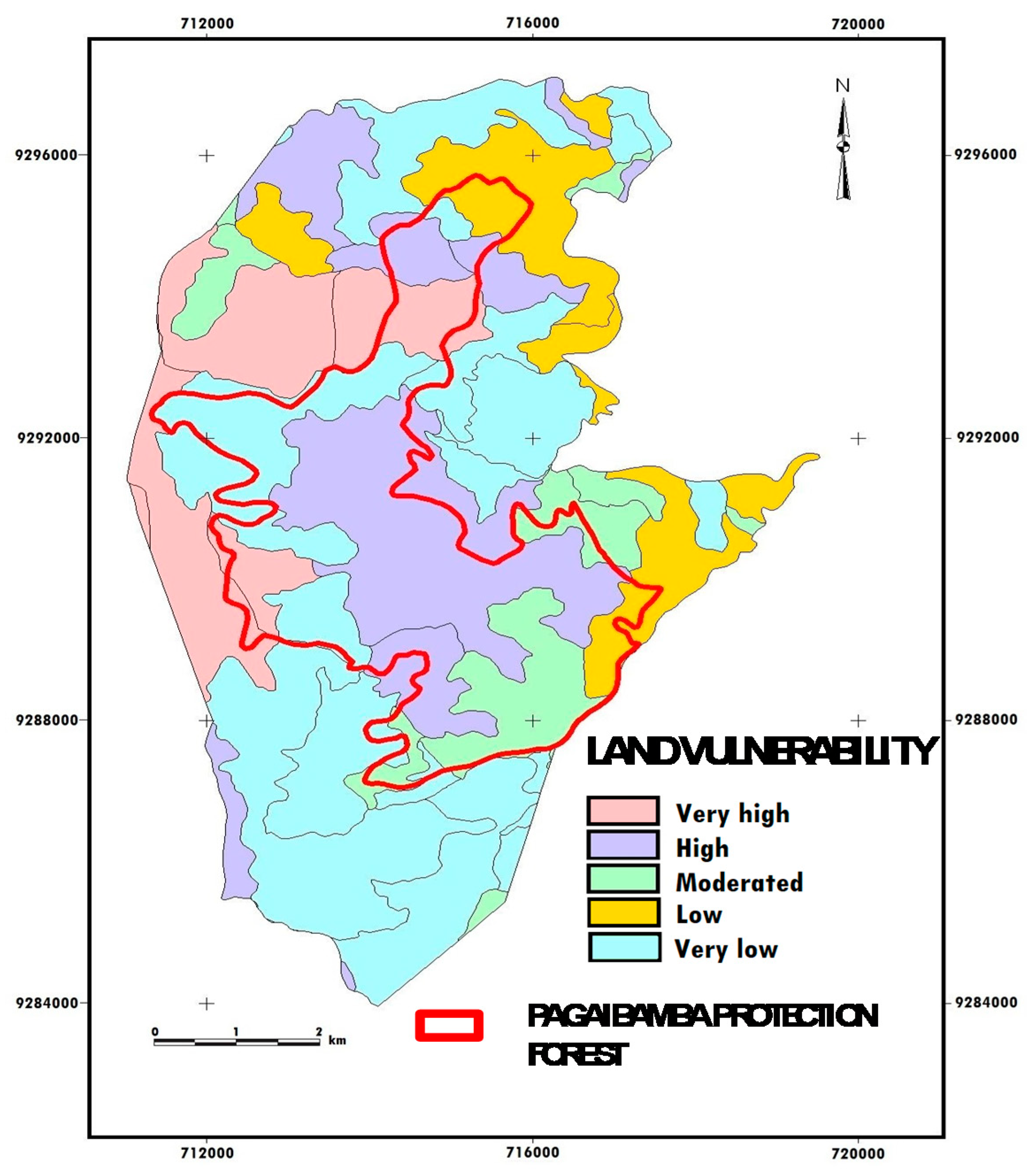
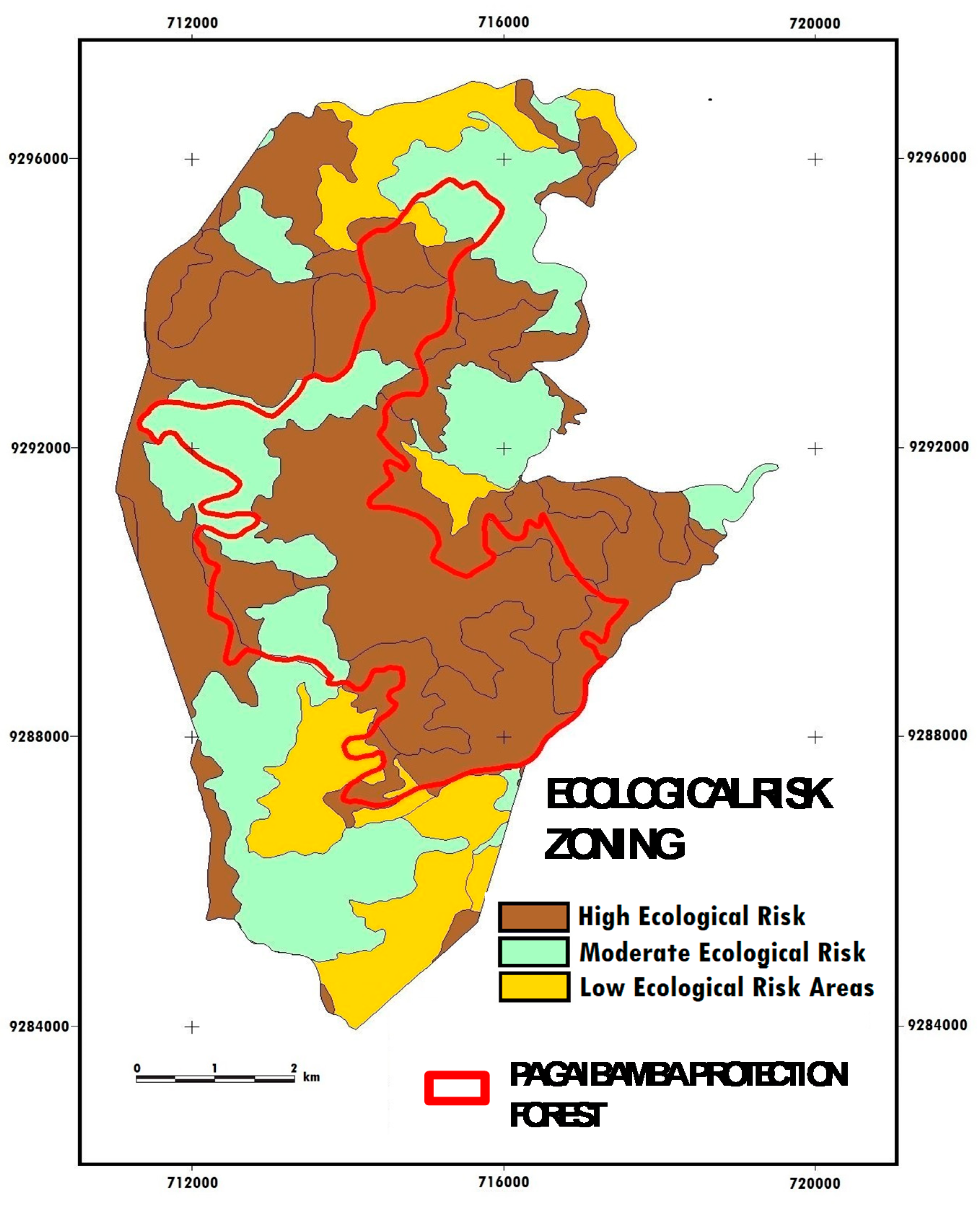
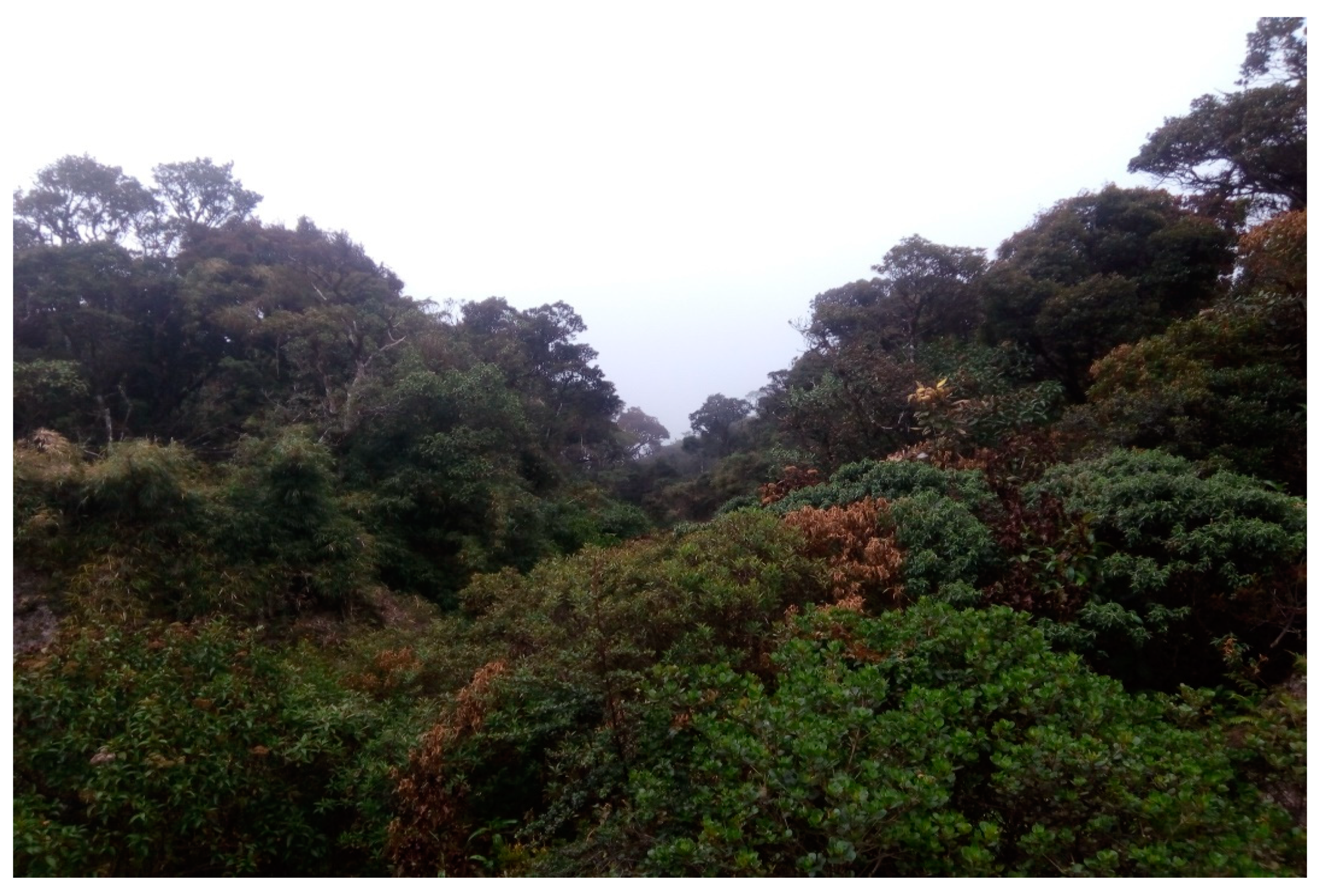
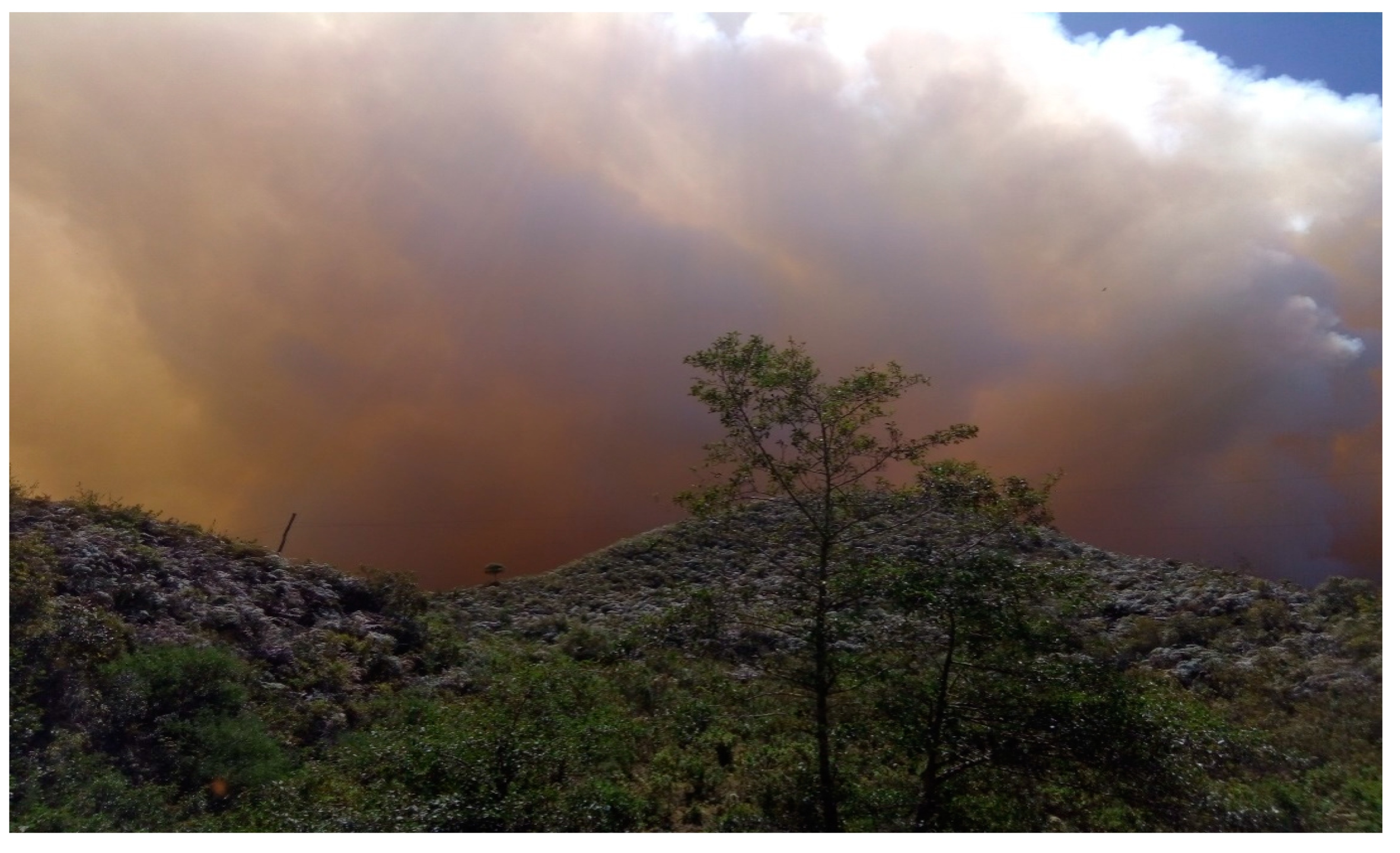
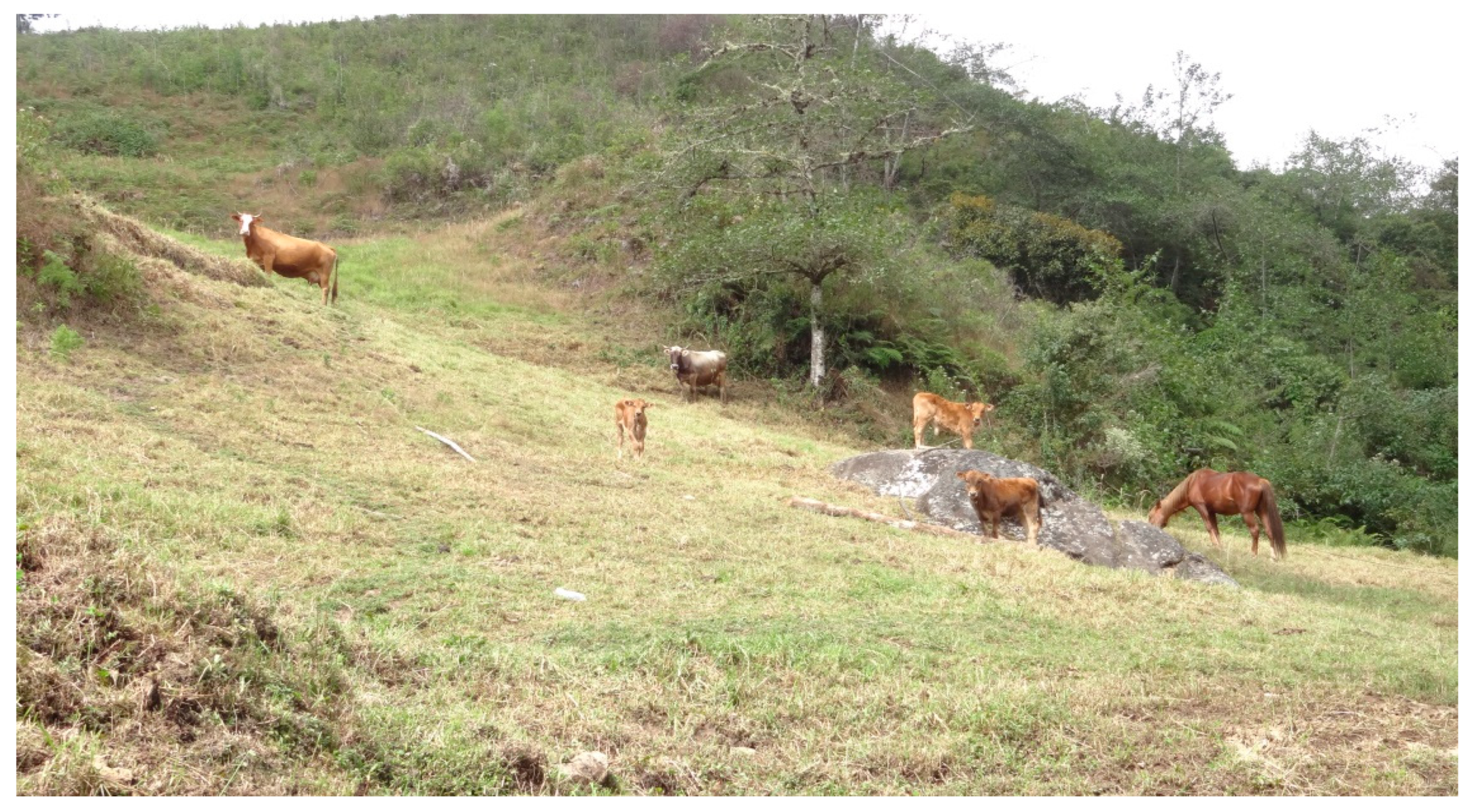
| Vulnerability Levels | Variables Used | Protected Natural Areas | ||||||||
|---|---|---|---|---|---|---|---|---|---|---|
| Physiographic—Geological | Topographic | Edaphic | ||||||||
| Relief | Slope (%) | Soil Name | Depth (cm) | Texture | Rock Fragments | ha | % | |||
| Low | Volcanic-sedimentary mountain slope | SI | 8–15 | Cachipampa | 80–90 | Sl/S | gravelly | 15–35% | 35.87 | 1.77 |
| Moderated | MS | 15–25 | Cachipampa | 80–90 | Sl/S | gravelly | 15–35% gravel | 265.16 | 13.10 | |
| SI | 8–15 | El Tendal | 90–100 | L/Scl | slightly gravelly | <15% gravel | ||||
| High | S | 25–50 | Cachipampa | 80–90 | Sl/S | gravelly | 15–35% gravel | 621.06 | 30.70 | |
| MS—S | 15–50 | El Tendal | 90–100 | L/Scl | slightly gravelly | <15% gravel | ||||
| Very high | VS | 50–75 | Cachipampa | 80–90 | Sl/S | gravelly | 15–35% gravel | 1101.11 | 54.43 | |
| VS | 50–75 | El Tendal | 90–100 | L/Scl | slightly gravelly | <15% gravel | ||||
| S—VS | 25–75 | Rocky outcrop | <15 | very stony | 35–60% stones | |||||
| Total | 2023.20 | 100.00 | ||||||||
| Vulnerability Levels | Variables Used | Protected Natural Areas | ||||||||
|---|---|---|---|---|---|---|---|---|---|---|
| Physiographic—Geological | Topographic | Edaphic | ||||||||
| Relief | Slope (%) | Soil Name | Depth (cm) | Texture | Rock Fragments | ha | % | |||
| Very Low | Volcanic-sedimentary mountain slope | SI | 8–15 | Los Molinos | 120–150 | L/Cl | slightly gravelly | <15% gravel | 34.04 | 0.82 |
| Low | SI | 8–15 | Cachipampa | 80–90 | Sl/S | gravelly | 15–35% gravel | 608.25 | 14.61 | |
| Moderated | MS | 15–25 | Cachipampa | 80–90 | Sl/S | gravelly | 15–35% gravel | 1257.97 | 30.19 | |
| Los Molinos | 120–150 | L/Cl | slightly gravelly | <15% gravel | ||||||
| SI | 8–15 | El Tendal | 90–100 | L/Scl | slightly gravelly | <15% gravel | ||||
| High | S | 25–50 | Cachipampa | 80–90 | Sl/S | gravelly | 15–35% gravel | 1284.97 | 30.84 | |
| S | 25–50 | Los Molinos | 120–150 | L/Cl | slightly gravelly | <15% gravel | ||||
| MS—S | 15–50 | El Tendal | 90–100 | L/Scl | slightly gravelly | <15% gravel | ||||
| Very high | VS | 50–75 | Cachipampa | 80–90 | Sl/S | gravelly | 15–35% gravel | 980.48 | 23.54 | |
| VS | 50–75 | Los Molinos | 120–150 | L/Sc | slightly gravelly | <15% gravel | ||||
| VS | 50–75 | El Tendal | 90–100 | L/Scl | slightly gravelly | <15% gravel | ||||
| S—VS | 25–75 | Rocky outcrop | <15 | very stony | 35–60% stones | |||||
| Total | 4165.71 | 100.00 | ||||||||
| Ecological Risk Zonning | Criteria Used | Protected Natural Area | Buffer Zone | |||||
|---|---|---|---|---|---|---|---|---|
| Ecological Value | Productive Aptitude | Vulnerability | ha | % | ha | % | ||
| High Ecological Risk | High | Protection Conservation | Xse | High and Very high | 1722.18 | 85.13 | 2265.45 | 54.38 |
| Forest | F3se, F3sec | High | ||||||
| Moderate Ecological Risk | Medium | Livestock | P3se, P3se (t) | Medium, Low | 265.16 | 13.10 | 1257.97 | 30.19 |
| Low Ecological Risk | Low | Agricultural | A3sec, C3se | Low and Very low | 35.87 | 1.77 | 642.29 | 15.43 |
| Total | 2023.20 | 100.00 | 4165.71 | 100.00 | ||||
Publisher’s Note: MDPI stays neutral with regard to jurisdictional claims in published maps and institutional affiliations. |
© 2022 by the authors. Licensee MDPI, Basel, Switzerland. This article is an open access article distributed under the terms and conditions of the Creative Commons Attribution (CC BY) license (https://creativecommons.org/licenses/by/4.0/).
Share and Cite
Escobedo-Monge, M.A.; Aparicio, S.; Valencia Ramos, M.; Escobedo-Monge, M.F.; Parodi-Román, J.; García-Llatas, L.F.; Marquina Pozo, R. Land Vulnerability, Risk Zoning, and Ecological Protection in the Protection Forest of Pagaibamba (Peru). Forests 2022, 13, 436. https://doi.org/10.3390/f13030436
Escobedo-Monge MA, Aparicio S, Valencia Ramos M, Escobedo-Monge MF, Parodi-Román J, García-Llatas LF, Marquina Pozo R. Land Vulnerability, Risk Zoning, and Ecological Protection in the Protection Forest of Pagaibamba (Peru). Forests. 2022; 13(3):436. https://doi.org/10.3390/f13030436
Chicago/Turabian StyleEscobedo-Monge, María Antonieta, Santiago Aparicio, Manuel Valencia Ramos, Marlene Fabiola Escobedo-Monge, Joaquín Parodi-Román, Luis Felipe García-Llatas, and Rubén Marquina Pozo. 2022. "Land Vulnerability, Risk Zoning, and Ecological Protection in the Protection Forest of Pagaibamba (Peru)" Forests 13, no. 3: 436. https://doi.org/10.3390/f13030436








